Energy use tends to be the biggest cost that your building has some control over, so energy efficiency is one of the most meaningful things you can do for your building’s finances. Energy efficiency has lots of benefits: it improves resident comfort; it reduces pests, air pollutants, and unwanted noise; it improves the health of the people who live in the building; and it protects the health of our planet.
Everyone in the building has a role to play in energy efficiency. Board members and residents should seek out further resources and trainings on their specific building systems. Urban Green Council and Building Energy Exchange both have free resources for board members to learn about technology. CUNY’s Building Performance Lab has free thirty hour trainings for any super or board member. Knowing your building systems and how to take care of them will help you keep them running smoothly and save money on fuel.
This resource will cover low-cost ways to save money on heat. First we’ll cover the stack effect, an important concept to understand how heat flows through your building. Next, we’ll go over weatherization, which helps keep warm air in and cold air out. Next, we’ll explain the basics of steam heat and give a few pointers for keeping your heating system in working order. Finally, we’ll share some boiler room maintenance tips and explore how shareholders, tenants, supers, and board members can work together to increase efficiency.
Weatherization and the Stack Effect:
Did you know that you have two chimneys in your building? Both of them allow heat produced by your boiler to escape from your building. The first chimney is the one connected to your boiler. The second is your hallway and stairs. In fact, if your building has an elevator, then you have THREE chimneys in your building! Anytime you have a vertical shaftway connected to your building and rising up to the roof, you have major potential source of heat loss due to the stack effect.
The stack effect takes place when there’s a vertical shaftway in your building such as a staircase or elevator, and when there are leaks in your building envelope. The building envelope is what separates the inside from the outside: the outer walls and doors, windows, roof, and foundation of the building.
Whenever the wind blows across the top of an open vertical shaft, it creates a reduced air pressure inside the shaft. This is similar to the principle which creates lift in an airplane wing. This reduced pressure allows any heat inside the shaft to rise more quickly and escape out the top. This reduced pressure will also pull the heat from under apartment doors and pull the cold air into the hallway from under the building’s entrance door.
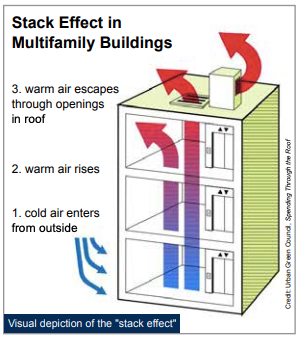
Because heat rises, cold air will enter the building through holes in the building envelope, warm up, rise to the top of the building, and escape, taking your heat with it.
The shaft doesn’t need to be completely open. Even a small opening such as a slightly open door to the roof or elevator shaft or a broken pane of glass in your hallway skylight can allow a tremendous amount of heat to escape.
Weatherization is the practice of sealing up your building envelope and other building areas to protect your building from the elements. Sealing up cracks and holes with foam insulation or caulk is one of the most cost-effective things you can do for energy efficiency – and if you don’t, your heat and money is literally pouring out of the building.
Weatherization is important in apartments, but especially in easy-to-forget common areas like the basement and bulkhead door. Because of the stack effect, these areas are essential to keeping your building warm in the winter. Many weatherization practices can also keep your building cooler in the summertime.
In common areas:
- Keep all roof and elevator shaft doors closed and weather strip them. Add door sweeps. Doors should be self-closing.
- Replace any broken windows in skylights. Insulate around the edges of skylights.
- All building entrance doors should have working door closers and latches including inner vestibule doors.
- All doors opening onto the public hallway including entrance, basement and apartment doors should have door sweeps.
- Insulate the roof.
- Make sure the basement is insulated, but be sure to leave adequate ventilation for the boiler.
- Seal cracks and holes wherever they appear. This also helps reduce pests.
Inside apartments:
- Remove air conditioners from windows during the winter. Having an air conditioner in the window allows a tremendous amount of heat to escape. If possible, the co-op can offer storage space in the basement for air conditioners. If residents absolutely cannot remove the window units, they can use special insulating covers to reduce heat loss.
- Thick rugs and curtains are a great way to insulate apartments.
Understanding Your Heating System
Understanding your heating system is key to identifying and solving heating problems. One big problem in HDFCs is uneven heat: when some apartments are too hot, and some are too cold. To understand uneven heat and what to do about it, it’s necessary to understand how heat is moving through a building.
Heating systems can be steam or hot water. This resource will focus on steam, a more common heating technology in older buildings. If you have a hot water heating system, Urban Green Council and Building Energy Exchange both have great resources on all kinds of heating systems. Electrified heating is also an increasingly common form of heating throughout the country.
Steam heating systems can be either one pipe or two pipe. If you have a steam heating system, you can easily see if your system is one-pipe or two-pipe by looking at a radiator.
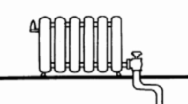
One-pipe heat:
- More common
- One pipe coming out of radiator
- Hot steam comes up the pipe, and exits as water down the same pipe
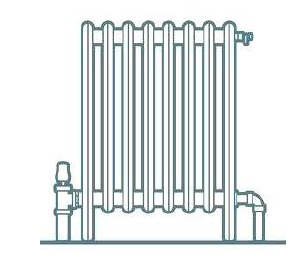
Two-pipe heat:
- Less common
- Two pipes coming out of radiator
- Hot steam comes up one pipe, and exits as water down the second pipe
Both types of radiators have a steam valve. Steam valves can turn a radiator on or off. It’s important not to leave steam valves halfway open or shut – far from the desired effect of moderating the heat, this traps water in the pipes and causes uneven heating. The steam valve cannot make the radiator get slightly more or less hot; it should only be used to turn heat all the way on or off.
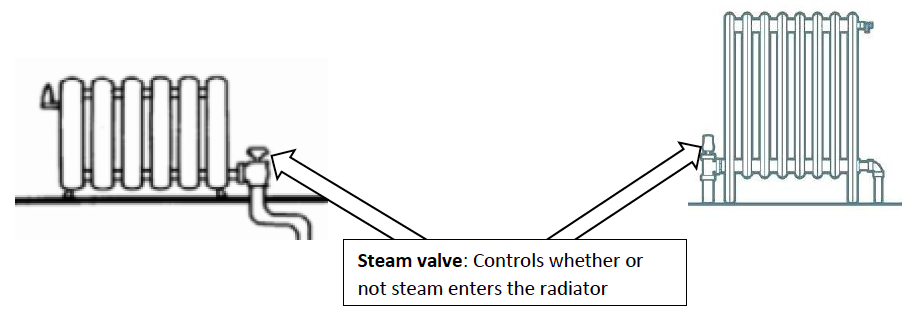
Both systems also have a way to vent air. Air vents should release air, but not steam.
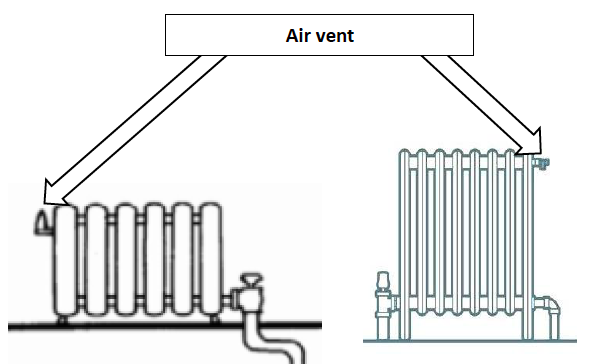
To understand why venting air is important, let’s take a look at a line of apartments in a one-pipe steam system.
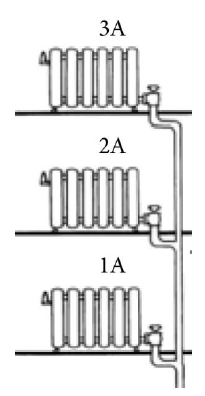
Radiators on the same line are connected by the same “riser,” the vertical pipe through which steam, water, and air all move.
When the heating system is off, the pipes and radiators are filled with air. When the heating system turns on, air escapes through the top of the system through individual air vents and master vents, creating a low pressure zone, and steam flows up through the pipes to fill it. The steam first goes to apartment 1A, then continues to 2A, and then 3A.
When the system is working properly, vents let out air but no steam, and steam moves quickly so the apartments heat up at roughly the same time.
However, if vents are broken in a “closed” position, no air can escape and steam can’t quickly enter the pipes. If vents are broken in an “open” position, steam is being lost instead of continuing to heat apartments. Either way, the apartments on the bottom are too hot and the apartments on the top are not heating up fast enough.
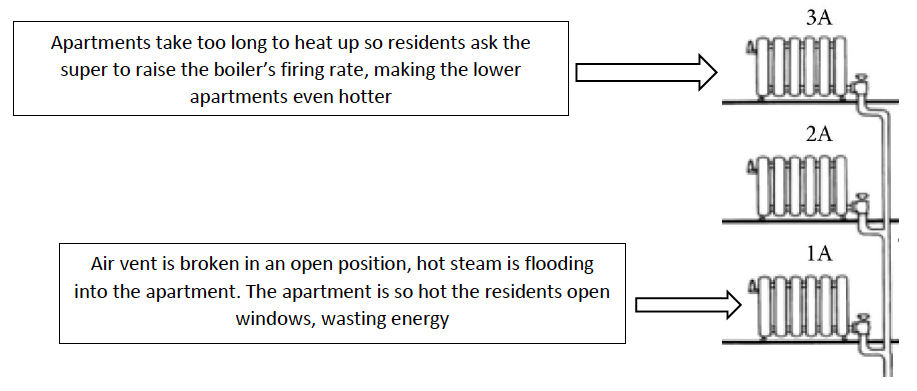
What can you do to fix an unbalanced system?
- Regularly test and replace air vents. Air vents have a short lifespan of only a couple years. Ideally, the super should test and replace all faulty air vents every summer.
- Make sure air vents are properly sized. Air vents come in different sizes. The larger the air vent, the faster it can vent air. Generally, apartments on higher floors and further corners of the building should have larger air vents, because steam takes longer to travel there.
- Consider thermostatic radiator valves (TRVs.) TRVs are a device you can attach to the end of your radiator to help modulate the temperature.
- Turn off radiators in overheated apartments. New York City apartments are often overheated. Especially on the lower floors, the heat from the risers alone may be enough to heat some rooms. Twist the steam valve all the way to the closed position to safely shut off your radiator.
- Consider adding “master vents” at the points of the system furthest from the boiler to vent air more quickly.
- Communicate about heating conditions. If apartment 1A is boiling hot but apartment 2A is ice cold, there must be heat getting lost somewhere along the way. Do regular surveys of heating conditions to identify problems. Heating problems should be reported to the maintenance and repairs committee.
Whose responsibility is it to maintain the heating system?
Radiators are part of the building-wide heating system, which is the co-op’s responsibility to maintain and pay for. However, they’re also inside shareholders’ apartments, meaning they’re the shareholder’s responsibility to maintain and pay for. For this reason, radiators are in a grey area. Your HDFC should come up with your own policy around radiators. However, there are big advantages to handling heating system maintenance collectively. If shareholders don’t know what they’re doing, they can break their radiator without realizing it, which has an effect on the comfort of the residents around them too. It’s also hard to make sure everyone has right-sized air vents if repair is happening piecemeal and by different people. If you have capacity, do an annual heating systems check for all radiators.
Boiler room energy-saving tips
A well-maintained boiler is essential to building health. Be sure whoever’s maintaining your boiler checks on it often and knows the system. When you need to replace the boiler, contact UHAB and do research to see how you can get a more efficient system through downsizing (most boilers are oversized) or doing a fuel conversion.
- The boiler’s firing rate is what controls how hot radiators ultimately get. You want to stop the boiler from cycling—turning on and off many times and releasing a lot of heat all at once. (Most boilers are oversized and produce too much heat at once!) Improving the burner’s modulation—its ability to adjust the boiler’s firing rate—can yield some of the greatest efficiency improvements.
- Boilers need proper ventilation because they require oxygen for the combustion process.
- Stop all steam and water leaks in the heating system! Steam leaks are very wasteful because the system loses hot water and the boiler has to work longer to heat up the new (cold) water coming in. Leaks are also very destructive to your boiler; the new water will rust out the boiler very quickly. Check for leaks around on/off valves on radiators. Also check for leaks in the return line.
- Chemically treat the boiler water periodically to prevent undue rusting.
- Insulate all pipes that are warm to the touch.
- Have the boiler and burner cleaned and tuned by your service company as often as necessary (more often for #4 and #6 oil, less often for gas). Make sure your boiler has at least 80% combustion efficiency.
- Keeping an energy efficient building is everyone’s responsibility. Tenants, shareholders, board members, and building operators should work together to set best practices, do preventative maintenance, and create a holistic energy plan. You should understand your particular building system. Analyze your budget to see where you have high costs—it could be water, heating oil, or electricity—and explore options to increase efficiency. Budget for regular energy upgrades. Consider forming an energy committee to survey residents about heating concerns and make a plan to address them. UHAB’s energy services are here to help. Contact UHAB to learn more.